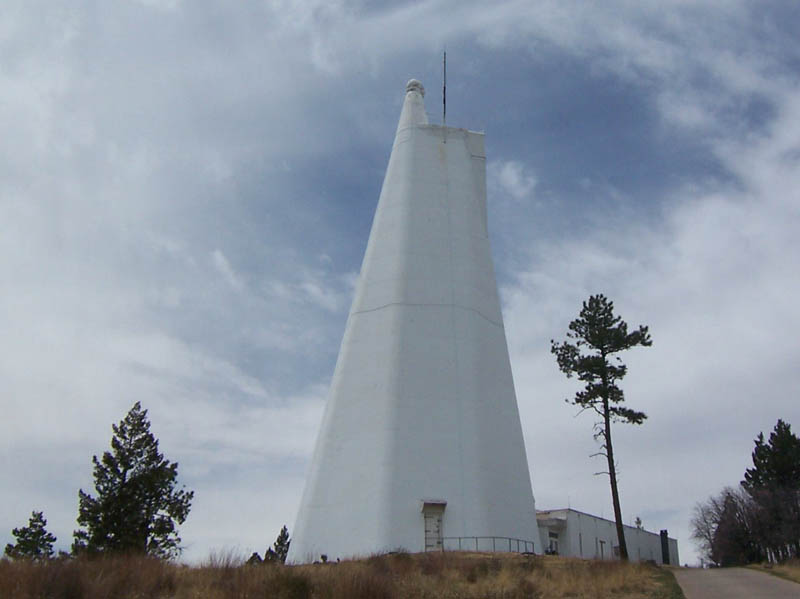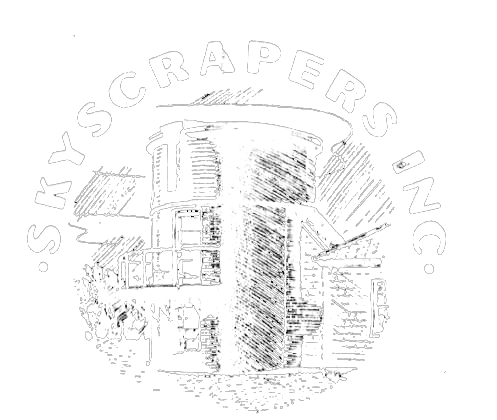Skip navigation
 The National Solar Observatory: The Vacuum Tower (Dunn Solar Telescope). This picture shows the Vacuum Tower telescope (known formally as the Dunn Solar Telescope). All the way at the top you can just see a round thing, and there is another one connected to it at the back. This structure contains an entrance window and two mirrors that guide the light of the Sun down the tower in a tube from which the air has been removed. The light travels through the 329 ft (100 m) long tube in a vacuum, and that's why the tower is called the Vacuum Tower. The light is made to go through a vacuum because a vacuum cannot change the light. If there were air inside the tube, then the sunlight could heat it up and then the air could make the image of the Sun appear to shimmer, just as when you look across a hot road in summer. Because the telescope magnifies the image of the Sun, it would also magnify the shimmering.
The tower is an impressive 136 feet (41.5 m) tall, but the building has 228 more feet (69.5 m) below ground, so most of the building is in fact not visible. After the light has hit the two mirrors at the top, it goes straight down the tube at the center of the tower, all the way down until it hits the primary mirror, 188 ft (57 m) below the ground. The primary mirror is 64 inches (163 cm) in diameter. It focuses the light and sends it back up to ground level, where it exits the vacuum tube and can be guided into the scientists' experiments on the optical benches.
The National Solar Observatory: The Vacuum Tower (Dunn Solar Telescope). This picture shows the Vacuum Tower telescope (known formally as the Dunn Solar Telescope). All the way at the top you can just see a round thing, and there is another one connected to it at the back. This structure contains an entrance window and two mirrors that guide the light of the Sun down the tower in a tube from which the air has been removed. The light travels through the 329 ft (100 m) long tube in a vacuum, and that's why the tower is called the Vacuum Tower. The light is made to go through a vacuum because a vacuum cannot change the light. If there were air inside the tube, then the sunlight could heat it up and then the air could make the image of the Sun appear to shimmer, just as when you look across a hot road in summer. Because the telescope magnifies the image of the Sun, it would also magnify the shimmering.
The tower is an impressive 136 feet (41.5 m) tall, but the building has 228 more feet (69.5 m) below ground, so most of the building is in fact not visible. After the light has hit the two mirrors at the top, it goes straight down the tube at the center of the tower, all the way down until it hits the primary mirror, 188 ft (57 m) below the ground. The primary mirror is 64 inches (163 cm) in diameter. It focuses the light and sends it back up to ground level, where it exits the vacuum tube and can be guided into the scientists' experiments on the optical benches.
See Also
New Mexico 2006
 The National Solar Observatory: The Vacuum Tower (Dunn Solar Telescope). This picture shows the Vacuum Tower telescope (known formally as the Dunn Solar Telescope). All the way at the top you can just see a round thing, and there is another one connected to it at the back. This structure contains an entrance window and two mirrors that guide the light of the Sun down the tower in a tube from which the air has been removed. The light travels through the 329 ft (100 m) long tube in a vacuum, and that's why the tower is called the Vacuum Tower. The light is made to go through a vacuum because a vacuum cannot change the light. If there were air inside the tube, then the sunlight could heat it up and then the air could make the image of the Sun appear to shimmer, just as when you look across a hot road in summer. Because the telescope magnifies the image of the Sun, it would also magnify the shimmering.
The tower is an impressive 136 feet (41.5 m) tall, but the building has 228 more feet (69.5 m) below ground, so most of the building is in fact not visible. After the light has hit the two mirrors at the top, it goes straight down the tube at the center of the tower, all the way down until it hits the primary mirror, 188 ft (57 m) below the ground. The primary mirror is 64 inches (163 cm) in diameter. It focuses the light and sends it back up to ground level, where it exits the vacuum tube and can be guided into the scientists' experiments on the optical benches.
The National Solar Observatory: The Vacuum Tower (Dunn Solar Telescope). This picture shows the Vacuum Tower telescope (known formally as the Dunn Solar Telescope). All the way at the top you can just see a round thing, and there is another one connected to it at the back. This structure contains an entrance window and two mirrors that guide the light of the Sun down the tower in a tube from which the air has been removed. The light travels through the 329 ft (100 m) long tube in a vacuum, and that's why the tower is called the Vacuum Tower. The light is made to go through a vacuum because a vacuum cannot change the light. If there were air inside the tube, then the sunlight could heat it up and then the air could make the image of the Sun appear to shimmer, just as when you look across a hot road in summer. Because the telescope magnifies the image of the Sun, it would also magnify the shimmering.
The tower is an impressive 136 feet (41.5 m) tall, but the building has 228 more feet (69.5 m) below ground, so most of the building is in fact not visible. After the light has hit the two mirrors at the top, it goes straight down the tube at the center of the tower, all the way down until it hits the primary mirror, 188 ft (57 m) below the ground. The primary mirror is 64 inches (163 cm) in diameter. It focuses the light and sends it back up to ground level, where it exits the vacuum tube and can be guided into the scientists' experiments on the optical benches.



